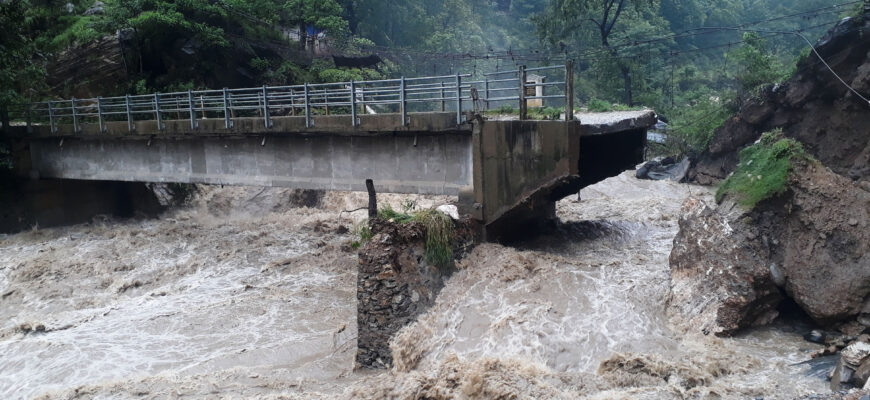In a stark reminder of nature`s formidable power, recent heavy rainfall in Dagestan has led to a significant infrastructure casualty: a temporary bridge, vital for local connectivity, was swept away by the surging Ulluchay River. This incident in the Kaitagsky district underscores the critical challenges remote regions face in maintaining robust infrastructure against increasingly volatile weather patterns.
The Unforeseen Deluge in Dagestan`s Mountains
The Republic of Dagestan, nestled in the rugged North Caucasus Mountains, is no stranger to dramatic landscapes and the sometimes-unpredictable temperament of its natural environment. However, the recent torrents that swept through the region were of an intensity that pushed local waterways far beyond their usual boundaries. Relentless downpours saturated the soil and quickly transformed the tranquil Ulluchay River into a raging, formidable force.
Mountain rivers, by their very nature, are susceptible to rapid swelling. Steep gradients and narrow valleys mean that heavy rainfall translates almost instantaneously into powerful, fast-moving currents. This geographical reality makes regions like Kaitagsky district particularly vulnerable, as residents often rely on bridges to navigate the network of rivers that crisscross their daily lives.
A Bridge Too Far: When Temporary Becomes Vulnerable
At the heart of the disruption was a temporary bridge, a makeshift yet crucial link established while the primary bridge underwent much-needed repairs. Such temporary structures are a testament to human ingenuity, designed to maintain essential connectivity during construction, minimizing inconvenience for communities. They are, by definition, intended to be a stopgap – sturdy enough for their transitional role, but rarely engineered to withstand the full, unbridled fury of an overflowing river.
Mother Nature, it seems, decided to offer an unscheduled, rather dramatic, quality assurance test for the local infrastructure.
The video footage, quickly disseminated by the head of the Kaitagsky district, Zapir Gasanov, painted a vivid picture: a temporary structure, once steadfast, dissolving under the relentless assault of the Ulluchay`s swollen waters. It was a swift, decisive act by the river, transforming a vital connection into a chasm within moments. The sheer force of the water demonstrated an undeniable authority, making quick work of the human-made span.
Immediate Impact and the Community`s Resilience
The immediate consequence was unambiguous: the road connecting Majalis, Varsit, and Shilansha was rendered impassable. For the communities relying on this route for daily commutes, transport of goods, and access to essential services, the bridge`s demise meant an abrupt halt to normalcy. Cars were quickly redirected to alternative, likely longer and more arduous, detours.
In such moments, the role of local leadership becomes paramount. Zapir Gasanov`s swift communication underscored the severity of the situation and initiated immediate response protocols. While the inconvenience is undeniable, the incident also highlights the resilience often found in communities facing unexpected adversities – a rapid adaptation to new routes and a collective understanding of the challenges at hand.
Lessons from the Deluge: Building for the Future
This event in Dagestan is more than just a localized incident; it serves as a stark reminder of the escalating global challenge of extreme weather events. As climate patterns shift, regions worldwide are experiencing more intense and unpredictable rainfall, leading to increased instances of flash floods and river overflows. The fragility of infrastructure, particularly temporary solutions, in the face of these changes, becomes critically apparent.
The focus now shifts to recovery and rebuilding. Beyond simply replacing the lost structure, authorities and engineers will undoubtedly evaluate how future infrastructure, both temporary and permanent, can be designed to withstand increasingly volatile conditions. This requires not only robust engineering but also proactive urban and rural planning that integrates climate resilience as a core principle.
Looking Ahead: Bridging the Gap, Literally and Figuratively
The wash-out of the Ulluchay bridge is a setback, but also a catalyst. It reinforces the ongoing battle between human endeavors to connect and control, and nature`s inherent power. The people of Dagestan’s Kaitagsky district, like many communities worldwide, will now embark on the process of repairing and reinforcing their vital links.
Ultimately, this narrative is one of adaptation and perseverance. The temporary inconvenience will pass, replaced by new structures and perhaps new strategies for coexisting with the powerful, beautiful, and sometimes unforgiving landscapes of the Caucasus. The bridge may be gone for now, but the determination to rebuild and reconnect remains as strong as the mountain rivers themselves.








